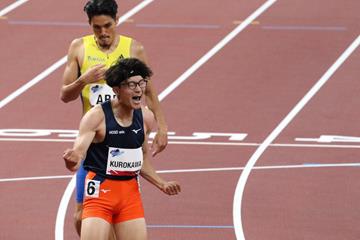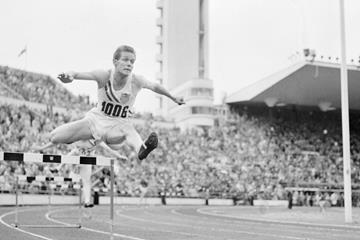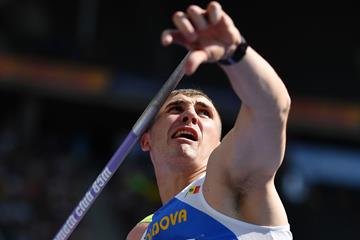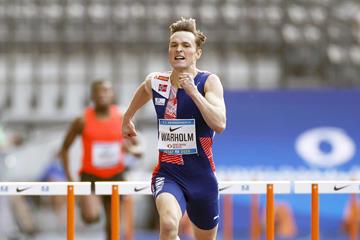 Countdown
Countdown
 Countdown
Countdown
The 400m hurdles is a demanding short-distance track and field event where athletes race one lap of a standard 400m track. Throughout the lap, runners must jump cleanly over 10 hurdles that are spaced evenly apart.
The first 440-yard hurdles race was staged in Oxford, England, circa 1860. Competitors had to tackle 12 huge (100cm) wooden barriers that were sunk into the ground
The men’s 400m hurdles has been an Olympic event since 1900
The women’s 400m hurdles event was first introduced at the 1984 Games
The first hurdle is placed 45 metres from the starting line and the following nine are placed every 35 metres after that
The height of the hurdle in the men’s event is 91.4cm (36 inches). It’s 76.2cm (30 inches) in the women’s event
An athlete can continue the race if they knock a hurdle over
Athletes are disqualified immediately following a false start
The first women’s 400m hurdles world record was set by Polish athlete Krystyna Kacperczyk in July 1974. She completed the race in a time of 56.51 seconds. For the next 21 years, the record was dominated by European athletes.
In 1977, World Athletics stipulated that all world record times for running events of 400m and below must be recorded using automatic timers to ensure accuracy and validity.
The first non-European world record-holder was US athlete Kim Batten, who beat Brit Sally Gunnell’s record of 52.74 with a time of 52.61. Batten held the record for eight years until Russian hurdler Yuliya Pechonkina broke the record in August 2003, with 52.34.
Since July 2019, two US athletes have broken the record a total of seven times. Dalilah Muhammad broke the record twice, with her fastest time being 52.16. Since then, Sydney McLaughlin-Levrone has broken it five times, with her fastest time of 50.65 achieved in June 2024.
The first men’s 400m hurdles world record was set by US athlete Charles Bacon in July 1908, with a time of 55 seconds. Bacon held the record for 12 years until fellow US hurdler Frank Loomis achieved a time of 54 seconds.
The first non-US athlete to beat the record was Sweden’s Sten Pettersson. He set a time of 53.8 in October 1925. Following this, five world records were set by three different US athletes, including Glenn Hardin, who achieved a time of 50.6 in July 1934.
The final pre-automatic timer world record was set by Ugandan hurdler John Akii-Bua, with a time of 47.8 seconds in the 1972 Munich Olympics Between July 1976 and July 2021, two US athletes held the record. Edwin Moses set a world record of 47.64, then broke it three more times, with the fastest being 47.02 in August 1983. Nine years later, Kevin Young broke the record at the 1992 Olympics in Barcelona with 46.78.
The current world record-holder is Norwegian athlete Karsten Warholm, who broke Young’s record in July 2021 with 46.70. Then, just one month later at the Tokyo Olympic Games, Warholm broke his own record with the first sub-46-second time, at 45.94.
The 400m hurdles is an incredibly challenging event, with athletes having to combine speed, power, agility, strength and balance. Athletes must be incredibly dedicated towards perfecting their skill and technique, so champions are often celebrated for their talent and dedication.
Notable men’s 400m hurdlers include Glenn Davis, Edwin Moses and Angelo Taylor, who each won two Olympic gold medals in the event. This feat has only ever been achieved by one non-US athlete, with the Dominican Republic’s Felix Sanchez winning gold in 2004 and 2012.
In the women’s 400m hurdles, Morocco’s Nawal El Moutawakel took the Olympic gold in the 1984 Games, and became the first female Olympic champion and the first woman to win Olympic gold from an Islamic nation. Other notable athletes include Britain’s Sally Gunnell, who won gold in the 1992 Olympics and the 1993 World Championships, and Femke Bol, who won bronze at the Tokyo Olympics and gold at the 2023 World Championships.
The three fastest athletes of all time in both the women’s and men’s events are all currently competing: Sydney McLaughlin-Levrone, Femke Bol and Dalilah Muhammad in the women’s event, and Karsten Warholm, Rai Benjamin and Alison dos Santos in the men’s event.
The 400m hurdles is a notoriously difficult race, and the 10 hurdles cause the body to produce a lot of lactic acid in the muscles. This makes them feel heavy and sluggish, meaning athletes usually end the race slower than they start. It also makes athletes more likely to knock over hurdles in the latter stages.
To win a race, athletes must have impeccable technique. The race may only last less than a minute, but it requires a huge amount of skill and determination. The 400m hurdles technique can be split into various phases:
Athletes take their position in their lane at the starting block, staggered on the bend to ensure every athlete runs an equal distance.
The starting block is placed behind the start line, with the front block two feet from the line and the rear block three feet behind the line. Athletes position their feet comfortably on each block, with their dominant foot on the front block.
Athletes will then place their hands behind the start line for balance and wait for the next phase.
On your marks,’ is called, which prepares the athletes. They plant their feet firmly in the blocks and centre their bodies in a low position. They focus their eyes forward.
‘Set,’ is then called, which signals that the race will begin any moment. Athletes raise their hips and prepare to push off the starting block.
Once the starting pistol is fired, it signals the start of the race. Athletes push off from the blocks as quickly as they can.
The first hurdle is typically 45 metres from the start line and is usually around 20 strides away. During this short time, athletes drive forward, taking care to stay in their lane and time their strides in preparation for the first hurdle. Athletes will want to run fast but still conserve energy so they can clear each of the 10 hurdles.
On the lead-up to the first hurdle, athletes maintain speed and adjust their stride so they can position their take-off carefully. The lead leg should be brought up to the chest and the trail leg should stay bent and close to the body.
The remaining nine hurdles are spaced 35 metres apart. Every hurdle is approached in the same way as the first. Due to the build-up of lactic acid, every hurdle will feel harder than the one before it, so athletes should take great care to get their legs up as high as possible to avoid knocking the hurdles, as this will slow them down further.
After clearing the final hurdle, which is 40 metres from the line, athletes will use the remainder of their energy to drive to the finish. As they reach the line, athletes thrust their chest forward, as the athlete whose torso crosses the line first is the winner.
At major championships, the format of the 400m hurdles is typically heats, semifinals and final. There are specific 400m hurdles rules to ensure races are fair for all athletes::
The 400m hurdles takes place on a standard 400m track. There are 10 hurdles spaced evenly around the track – the first hurdle after 45m then every 35 metres after that.
The height of the men’s hurdles is 91,4cm (36 inches) and the height of the women’s is 76.2 (30 inches).
The distance between the final hurdle and the finish line is 40 metres.
Athletes must stick to their designated lane and use starting blocks. They start in a staggered formation to ensure every athlete runs the exact same distance.
Athletes must clear every hurdle. Accidentally knocking over a hurdle doesn’t result in any kind of penalty, but deliberately knocking down a hurdle can result in disqualification.
As the hurdles aren’t fixed to the ground, athletes cannot stand on them like they can in the steeplechase.
There are several ways an athlete may be disqualified:
A false start
Stepping out of their assigned lane
Impeding another competitor
Deliberately knocking over a hurdle
Passing beside the top bar of the hurdle
Bypassing a hurdle
There are no rules surrounding legal wind speeds in the 400m hurdles.
In the men’s and women’s 400m hurdles, there are a total of 10 hurdles. The first is positioned 45 metres after the start line, the rest are then placed every 35 metres after that. The final hurdle is 40 metres from the finish line.
There are standard heights for the hurdles in the 400m hurdles, with differences between the men’s and women’s events:
Men’s hurdles - 91.4cm (36 inches)
Women’s hurdles - 76.2cm (30 inches)
During the 400m hurdles, the hurdles are spaced 35 metres apart. The distance between the start line and the first hurdle is 45 metres, and the distance between the final hurdle and the finish line is 40 metres.
Yes, the hurdles in the 400m hurdles can be knocked down easily if touched. If athletes are thought to be deliberately knocking down hurdles, it can lead to disqualification.
 USA
USA
 NOR
NOR
 BRA
BRA
 QAT
QAT
 NGR
NGR
 BRA
BRA
 USA
USA
 GER
GER
 USA
USA
 USA
USA
 NED
NED
 SVK
SVK
 USA
USA
 USA
USA
 USA
USA
 PAN
PAN
 JAM
JAM
 BEL
BEL
 ITA
ITA
 NOR
NOR







